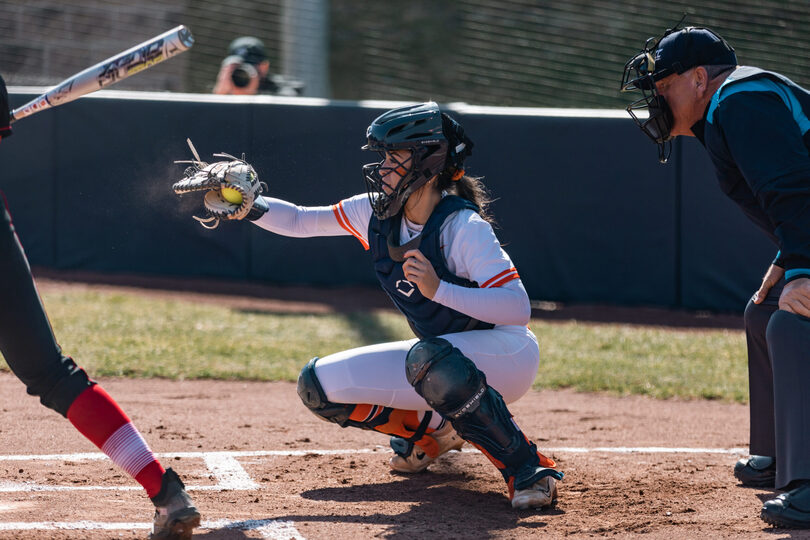Double threat: Laila Alves’ two-way ability transformed her into a weapon for the Orange

Joe Zhao | Staff Photographer
Laila Alves has shown a strong two-way ability for Syracuse this season as a catcher and hitter.
Get the latest Syracuse news delivered right to your inbox. Subscribe to our sports newsletter here.
As Matthew Alves was working in the front yard, his wife and kids watched Syracuse take on Virginia on a TV in the backyard. Matthew circled around and saw his daughter, Laila Alves, was up with the bases loaded.
The rest of his family informed Matthew that Alves fouled off a bunch of pitches and was in a battle. But, wanting to finish his work so he could watch the end of the game, Matthew returned to the front.
A couple minutes later, he heard loud screaming from the backyard and thought “no way.” On the 16th pitch, Alves hit her first-ever grand-slam, and just her second career home run to give Syracuse an early 4-0 lead in its win over Virginia on April 29.
“I was watching her eyes when she would look back at your pitcher, she had the look of like
‘you’re not going to beat me,’” said Lydia, Alves’ mother. “I could see her demeanor. I could see the way she was kind of talking to herself.”
Alves has started every game in Syracuse’s lineup this season. The catcher’s plate discipline has made her one of Syracuse’s best hitters. Setting career-highs in nearly every category, Alves is batting .308 with 23 RBIs, while providing unique defensive abilities as a left-handed catcher.

Betty Zamora, co-head coach at Lincoln High School (California), always batted Alves third or fourth in the lineup. Zamora said she could rely on Alves to get on base, and during her senior season, Alves’ bat strength increased.
At times during her senior season, Alves “put the team on her back” by constantly driving in runners with two outs, said Donna Toft, Lincoln’s other co-head coach. During a two-game stretch against Wheatland High School and Center High School, Alves hit six home runs in a row.
“You would think by the third time the coach would walk her, but they kept pitching to her,” Toft said.
Alves’ arm strength always stuck out and led to her love of playing catcher. While playing in youth leagues, she was the only one who didn’t complain about being behind the plate, Lydia said. Sometimes in 100 degree weather, Alves would catch three games in a row but never protested.
Jenny Topping, Alves’ catching coach, described catching as a position that finds you. If you try it one time and fall in love with it early on, then you’ll always like it, Topping said.
“It’s not one of those positions that you can just kind of be thrown into as you get older,” Topping said. “It’s really a mastering position. It takes much more than just doing.”
Alves’ parents got in contact with Topping to enhance her catching skills. Topping previously played for Washington and Cal State Fullerton before making the 2004 United States Olympic team. Like Alves, Topping was a lefty. She was just the second-ever lefty catcher to play in the Olympics.
Topping feels that being a lefty catcher is beneficial. She said it provides more angles for picking people off at the corners and helps with tagging at the plate.

Arlo Stone | Design Editor
Topping worked on the fundamentals with Alves, but didn’t have to correct much, calling her “a natural.” They worked on throws down to second, communication, anticipating balls in the dirt and footwork.
Topping compared catching to dancing, saying that you can’t go faster than what you’re capable of and it takes time to develop rhythm. Alves was a “natural dancer,” Topping said. She was smooth with her motions, connecting her feet to her upper-body movements.
“She picked up on the tools very quickly,” Topping said. “Essentially, the weekly lessons just became a confidence builder.”
Typically, catchers usually help catch balls for the coach during practice drills. But otherwise, they don’t get many reps. Topping was keen on getting Alves as many reps as possible.
“The lessons are huge because they help you to understand the nuances of the role of a catcher,” Topping said. “It’s so much more than just receiving a pitch from a pitcher. It’s commanding the field, it’s keeping the tempo.”
Throughout Alves’ high school career, players were afraid to run on her. Zamora said she set up plays and signals for Alves to try and pick players off. Usually, it was up to Alves to call the plays.
“If the coaches have faith in you, they’re gonna try to shape you and expect more out of you to be that position in that player,” Matthew said. “A lot of it had to do with the coaching and our coaches saying hey, you know, you need to be a leader on this.”





